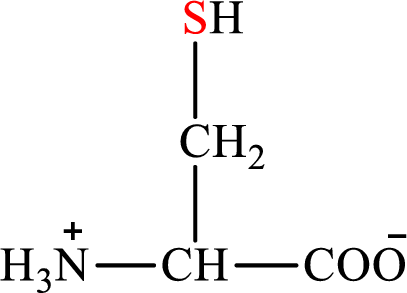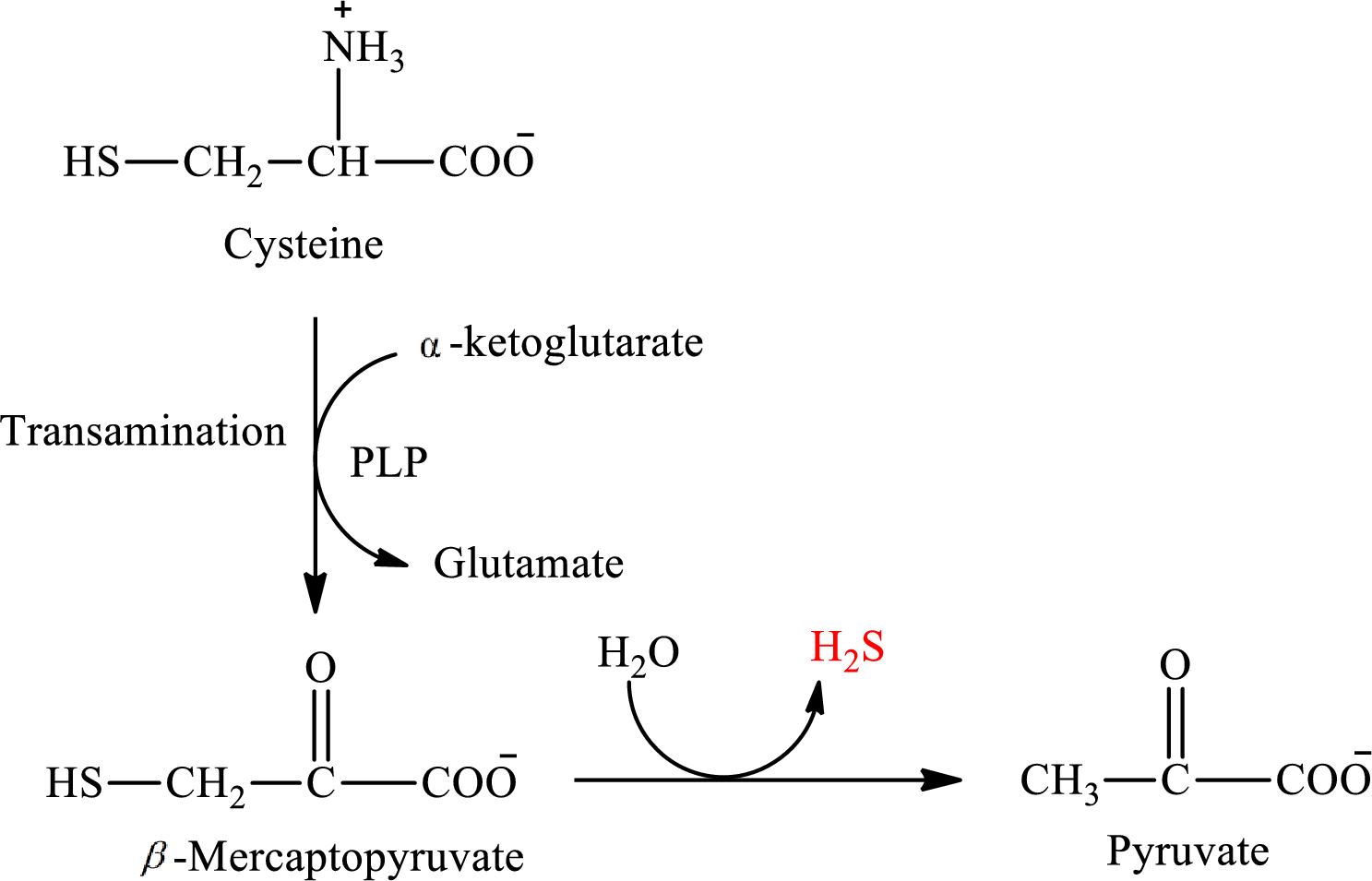
Organic And Biological Chemistry
7th Edition
ISBN: 9781305081079
Author: STOKER, H. Stephen (howard Stephen)
Publisher: Cengage Learning,
expand_more
expand_more
format_list_bulleted
Concept explainers
Question
Chapter 15.8, Problem 4QQ
Interpretation Introduction
Interpretation: To identify a nonmetabolic function for hydrogen sulfide.
Concept introduction: Cysteine is a nonessential amino acid and has a sulfur atom in its side chain. The structure of cysteine is:

In degradation of the sulfur-containing amino acid cysteine, the sulfur is released in the form of hydrogen sulfide. The degradation process of cysteine is as follows:

Expert Solution & Answer
Want to see the full answer?
Check out a sample textbook solution
Students have asked these similar questions
CH3CH2CH=CH2 + H₂O −
H+
Г
C-RSA CHROMATOPAC CH=1
DATA 1: @CHRM1.C00
ATTEN=10 SPEED= 10.0
0.0 b.092
0.797
1.088
1.813
C-RSA CHROMATOPAC CH=1 Report No. =13
** CALCULATION REPORT **
DATA=1: @CHRM1.000 11/03/05 08:09:52
CH PKNO
TIME
1
2
0.797
3
1.088
4
1.813
AREA
1508566
4625442
2180060
HEIGHT
207739
701206 V
287554 V
MK IDNO
CONC
NAME
18.1447
55.6339
26.2213
TOTAL
8314067 1196500
100
C-R8A CHROMATOPAC CH=1
DATA 1: @CHRM1.C00
ATTEN=10 SPEED= 10.0
0. 0
087
337.
0.841
1.150
C-R8A CHROMATOPAC CH=1 Report No. =14
DATA=1: @CHRM1.000 11/03/05 08:12:40
** CALCULATION REPORT **
CH PKNO
TIME
AREA
1
3 0.841
1099933
41.15
4039778
HEIGHT MK IDNO
170372
649997¯¯¯
CONC
NAME
21.4007
78.5993
TOTAL
5139711 820369
100
3
C-R8A CHROMATOPAC
CH=1
DATA 1: @CHRM1.C00
ATTEN=10 SPEED= 10.0
0.100
0:652
5.856
3
1.165
C-RSA CHROMATOPAC CH-1 Report No. =15
DATA=1: @CHRM1.000 11/03/05 08:15:26
** CALCULATION REPORT **
CH PKNO TIME
AREA
HEIGHT MK IDNO CONC
NAME
1 3 3 0.856
4
1.165
TOTAL
1253386
4838738
175481
708024 V
20.5739
79.4261
6092124…
Indicate the product that is obtained if the benzotriazole reacts with the use of a medium basic product.
Chapter 15 Solutions
Organic And Biological Chemistry
Ch. 15.1 - Which of the following statements about dietary...Ch. 15.1 - Dietary protein materials as they leave the...Ch. 15.1 - Prob. 3QQCh. 15.1 - Which of the following is not a proteolytic...Ch. 15.2 - The dominant use for the amino acids of the amino...Ch. 15.2 - The most abundant amino acid in the amino acid...Ch. 15.2 - Prob. 3QQCh. 15.3 - The reactants in a transamination reaction are a....Ch. 15.3 - Prob. 2QQCh. 15.3 - Prob. 3QQ
Ch. 15.3 - Prob. 4QQCh. 15.3 - Prob. 5QQCh. 15.3 - Prob. 6QQCh. 15.4 - Prob. 1QQCh. 15.4 - Prob. 2QQCh. 15.4 - Prob. 3QQCh. 15.4 - Prob. 4QQCh. 15.4 - Prob. 5QQCh. 15.4 - In the urea cycle, the urea-producing step...Ch. 15.5 - Which of the following statements concerning the...Ch. 15.5 - Prob. 2QQCh. 15.5 - Which of the following statements concerning the...Ch. 15.5 - Prob. 4QQCh. 15.6 - Prob. 1QQCh. 15.6 - Prob. 2QQCh. 15.6 - Prob. 3QQCh. 15.7 - Prob. 1QQCh. 15.7 - Prob. 2QQCh. 15.7 - In the degradation of heme, which of the following...Ch. 15.7 - In the degradation of heme, the iron atom present...Ch. 15.8 - In degradation of the sulfur-containing amino acid...Ch. 15.8 - Prob. 2QQCh. 15.8 - Prob. 3QQCh. 15.8 - Prob. 4QQCh. 15.9 - Prob. 1QQCh. 15.9 - Prob. 2QQCh. 15.9 - Prob. 3QQCh. 15.10 - Transamination reactions require the cofactor PLP...Ch. 15.10 - Prob. 2QQCh. 15.10 - Prob. 3QQCh. 15 - Prob. 15.1EPCh. 15 - Indicate whether each of the following aspects of...Ch. 15 - Prob. 15.3EPCh. 15 - Prob. 15.4EPCh. 15 - Prob. 15.5EPCh. 15 - Prob. 15.6EPCh. 15 - Prob. 15.7EPCh. 15 - Prob. 15.8EPCh. 15 - Prob. 15.9EPCh. 15 - Prob. 15.10EPCh. 15 - Prob. 15.11EPCh. 15 - Prob. 15.12EPCh. 15 - Prob. 15.13EPCh. 15 - Indicate whether each of the following statements...Ch. 15 - Prob. 15.15EPCh. 15 - Prob. 15.16EPCh. 15 - Prob. 15.17EPCh. 15 - What are the four major uses for amino acids...Ch. 15 - With the help of Table 26-1, classify each of the...Ch. 15 - Prob. 15.20EPCh. 15 - Prob. 15.21EPCh. 15 - Prob. 15.22EPCh. 15 - Prob. 15.23EPCh. 15 - Prob. 15.24EPCh. 15 - Prob. 15.25EPCh. 15 - Prob. 15.26EPCh. 15 - Prob. 15.27EPCh. 15 - Prob. 15.28EPCh. 15 - Prob. 15.29EPCh. 15 - Prob. 15.30EPCh. 15 - Prob. 15.31EPCh. 15 - Prob. 15.32EPCh. 15 - Prob. 15.33EPCh. 15 - Prob. 15.34EPCh. 15 - Prob. 15.35EPCh. 15 - Prob. 15.36EPCh. 15 - Prob. 15.37EPCh. 15 - Prob. 15.38EPCh. 15 - Prob. 15.39EPCh. 15 - Prob. 15.40EPCh. 15 - Prob. 15.41EPCh. 15 - Prob. 15.42EPCh. 15 - Draw the structure of the -keto acid produced from...Ch. 15 - Draw the structure of the -keto acid produced from...Ch. 15 - Prob. 15.45EPCh. 15 - Prob. 15.46EPCh. 15 - Prob. 15.47EPCh. 15 - Prob. 15.48EPCh. 15 - Prob. 15.49EPCh. 15 - Prob. 15.50EPCh. 15 - Prob. 15.51EPCh. 15 - Prob. 15.52EPCh. 15 - Prob. 15.53EPCh. 15 - Prob. 15.54EPCh. 15 - What is a carbamoyl group?Ch. 15 - Prob. 15.56EPCh. 15 - Prob. 15.57EPCh. 15 - Prob. 15.58EPCh. 15 - Prob. 15.59EPCh. 15 - Prob. 15.60EPCh. 15 - Prob. 15.61EPCh. 15 - Prob. 15.62EPCh. 15 - Prob. 15.63EPCh. 15 - Prob. 15.64EPCh. 15 - Prob. 15.65EPCh. 15 - Prob. 15.66EPCh. 15 - Prob. 15.67EPCh. 15 - Prob. 15.68EPCh. 15 - Prob. 15.69EPCh. 15 - Prob. 15.70EPCh. 15 - Prob. 15.71EPCh. 15 - Prob. 15.72EPCh. 15 - Prob. 15.73EPCh. 15 - Prob. 15.74EPCh. 15 - Prob. 15.75EPCh. 15 - Prob. 15.76EPCh. 15 - Prob. 15.77EPCh. 15 - Prob. 15.78EPCh. 15 - Prob. 15.79EPCh. 15 - Prob. 15.80EPCh. 15 - Prob. 15.81EPCh. 15 - Prob. 15.82EPCh. 15 - Prob. 15.83EPCh. 15 - Prob. 15.84EPCh. 15 - Prob. 15.85EPCh. 15 - Prob. 15.86EPCh. 15 - Prob. 15.87EPCh. 15 - What is the starting material for the biosynthesis...Ch. 15 - Prob. 15.89EPCh. 15 - Prob. 15.90EPCh. 15 - Prob. 15.91EPCh. 15 - Prob. 15.92EPCh. 15 - Prob. 15.93EPCh. 15 - What are the structural differences between...Ch. 15 - Prob. 15.95EPCh. 15 - Prob. 15.96EPCh. 15 - Which bile pigment is responsible for the yellow...Ch. 15 - Prob. 15.98EPCh. 15 - Prob. 15.99EPCh. 15 - Prob. 15.100EPCh. 15 - Prob. 15.101EPCh. 15 - Prob. 15.102EPCh. 15 - Prob. 15.103EPCh. 15 - Prob. 15.104EPCh. 15 - Prob. 15.105EPCh. 15 - Indicate whether each of the following statements...Ch. 15 - Prob. 15.107EPCh. 15 - Prob. 15.108EPCh. 15 - Prob. 15.109EPCh. 15 - Prob. 15.110EPCh. 15 - Prob. 15.111EPCh. 15 - Prob. 15.112EPCh. 15 - Prob. 15.113EPCh. 15 - Prob. 15.114EPCh. 15 - Prob. 15.115EPCh. 15 - Prob. 15.116EP
Knowledge Booster
Learn more about
Need a deep-dive on the concept behind this application? Look no further. Learn more about this topic, chemistry and related others by exploring similar questions and additional content below.Similar questions
- Indicate the product that is obtained if the benzotriazol reacts with dimethyl sulfate.arrow_forwardIndicate how to obtain 2-metilbencimidazol from 1,2-diaminobenzene.arrow_forwardbreak down both reactions shown and explain it correctly using the bromonium ion mechanism, instead of the (disproven) carbocation-based mechanism.arrow_forward
- Indicate how from 1,2-diaminobenzene to obtain 1-metilbenzotriazol.arrow_forward-C = C - C - + Br₂ + I" -> -C-C-c -C = C -C- + Br² + I₂ -C=C Br I + Brū + Iz -7- C - C-C- I Br Mechanism; - C = c - c - + Br - Br > - C-c-c- Br -C-C-C- + 1 - - -Ċ-Ċ'-c' - Br Br Iarrow_forwardWrite the mechanism of the esterification reaction (please show the mechanism included line pairs and arrows)arrow_forward
- How do I break down the reaction shown on the chalkboard and explain it correctly using the bromonium ion mechanism, instead of the (disproven) carbocation-based mechanismarrow_forward¿Qué the product is obtained from tetraethoxypropano and hidrazina?. Indicate the reason why the corresponding dial is used.arrow_forwardIf CH3COCH2CH(OCH3)2 is reacted with hydrazine, two isomeric products are formed. Indicate their structures and the major product.arrow_forward
- Is it possible to obtain addition derivatives to nitrogen in position 2 of pyrazoles by reaction with electrophilic agents? Reason for this.arrow_forwardStarting from 1,3-dicarbonyl derivatives to obtain isooxazoles and isothiazoles. Indicate whether synthetic methods exist.arrow_forwardIn the synthesis of benzotriazole, adding NaNO2 heats the solution. State the reason.arrow_forward
arrow_back_ios
SEE MORE QUESTIONS
arrow_forward_ios
Recommended textbooks for you
 General, Organic, and Biological ChemistryChemistryISBN:9781285853918Author:H. Stephen StokerPublisher:Cengage Learning
General, Organic, and Biological ChemistryChemistryISBN:9781285853918Author:H. Stephen StokerPublisher:Cengage Learning Organic And Biological ChemistryChemistryISBN:9781305081079Author:STOKER, H. Stephen (howard Stephen)Publisher:Cengage Learning,
Organic And Biological ChemistryChemistryISBN:9781305081079Author:STOKER, H. Stephen (howard Stephen)Publisher:Cengage Learning,

General, Organic, and Biological Chemistry
Chemistry
ISBN:9781285853918
Author:H. Stephen Stoker
Publisher:Cengage Learning

Organic And Biological Chemistry
Chemistry
ISBN:9781305081079
Author:STOKER, H. Stephen (howard Stephen)
Publisher:Cengage Learning,